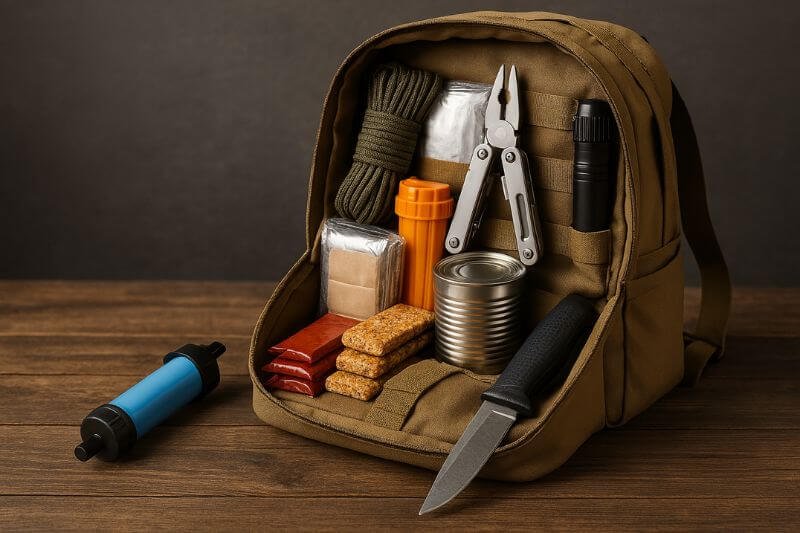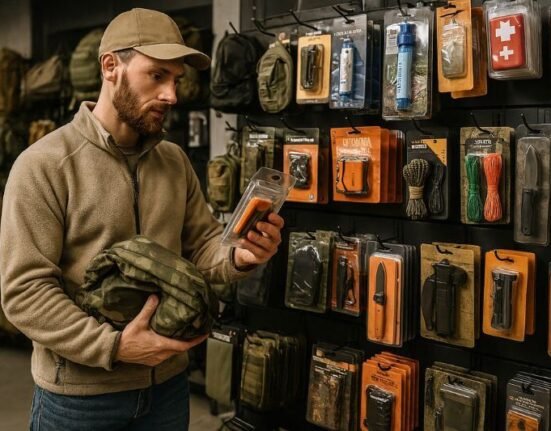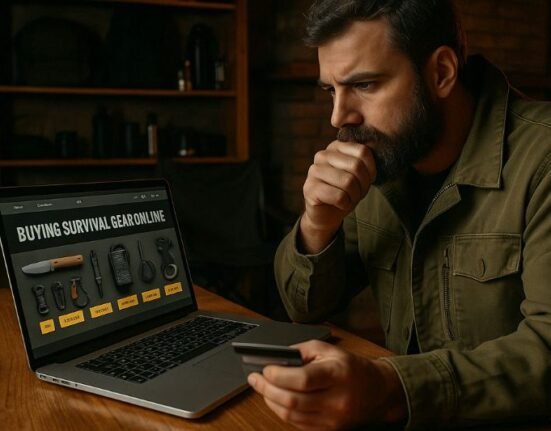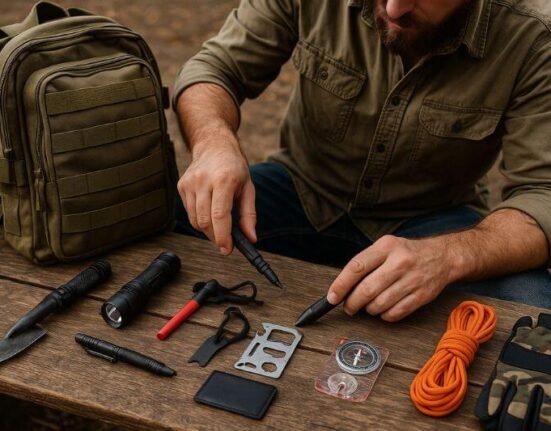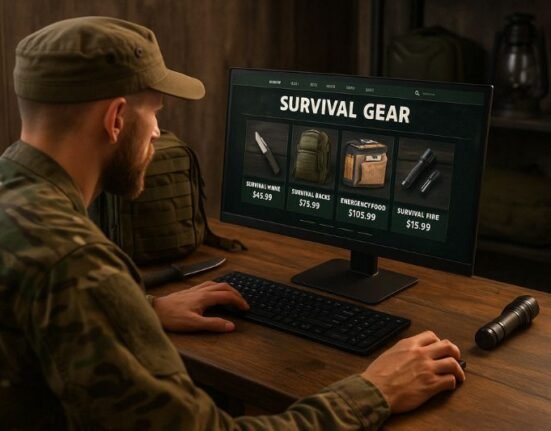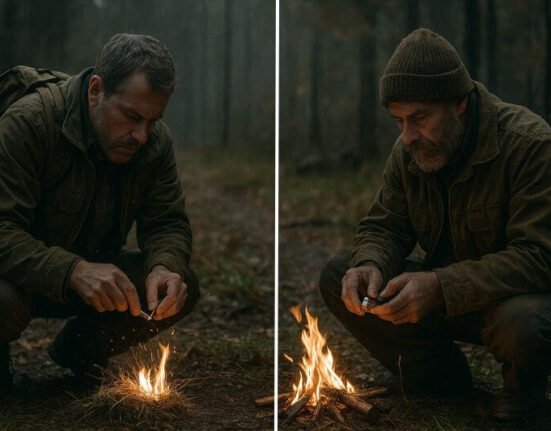When it comes to surviving a crisis, survival essentials aren’t just gear—they’re what stands between you and chaos. Whether you’re facing a power outage, a natural disaster, or complete societal breakdown, the right equipment can mean the difference between panic and preparedness.
But in a world flooded with “must-have” gear lists and flashy survival gadgets, one fundamental question remains:
What do you actually need to survive?
In this article, we break down the true essentials—not by brand or budget, but by purpose and function. We’ll help you strip away the noise and focus on what really matters when it comes to readiness.
🔎 Understanding Survival Essentials: It’s About Needs, Not Gear
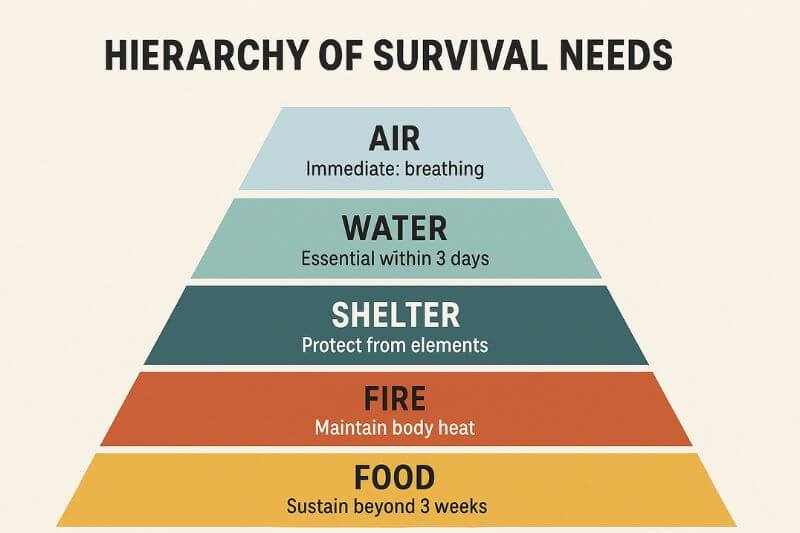
Most survival beginners think in terms of objects. A fire starter. A water filter. A knife. But real preppers think in terms of human needs. And that shift in mindset changes everything.
🧱 The Survival Hierarchy of Needs
At the core of any survival strategy lies a simple but powerful truth: humans have basic physical requirements that must be met to stay alive. These include:
- Air – Immediate need, but rarely a concern unless in toxic environments.
- Body temperature control (shelter, clothing, fire)
- Hydration – You need clean water within 72 hours, or your body starts to fail.
- Caloric energy – Food is less urgent but crucial for sustained functionality.
- Rest and recovery – Sleep and downtime are often overlooked but vital.
⛑️ To survive more than a few days, you need to control your environment, secure clean water, generate heat, and replenish your energy—all while staying mobile and safe.
This principle is what drives the design of every well-thought-out survival essentials list.
🧰 The Core Categories of Survival Essentials
Let’s break down the five foundational categories that every survivalist should cover.
1. 🔥 Fire & Heat Generation
Why it’s essential: Hypothermia can kill faster than dehydration. Fire also allows cooking, sterilizing tools, signaling, and boosting morale.
What to include:
- Ferrocerium rod or magnesium fire starter
- Windproof lighter (refillable)
- Waterproof matches
- Tinder (cotton balls + petroleum jelly, fatwood, char cloth)
💡 Pro tip: Always carry at least two fire-making tools in separate locations.
2. 💧 Water Procurement & Purification
Why it’s essential: Dehydration impairs mental clarity and physical function. In contaminated environments, drinking the wrong water can be lethal.
What to include:
- Portable water filter (like Sawyer Mini or LifeStraw)
- Purification tablets (chlorine dioxide)
- Collapsible water bottle or canteen
- Small metal pot or container for boiling
- Pre-filter cloth or bandana
Did you know?
3 liters/day per person is the average need in temperate conditions. In heat or high stress, it can double.
3. 🏕️ Shelter & Temperature Control
Why it’s essential: Exposure to the elements (cold, heat, wind, rain) is a silent killer in survival scenarios.
What to include:
- Emergency bivy sack or space blanket
- Compact tarp (8×10 ft minimum)
- Paracord or cordage
- Extra wool socks and gloves
- Mylar sleeping bag or insulated pad
🌡️ Don’t wait to feel cold before setting up shelter. Prevention is survival.
4. 🔪 Tools & Self-Defense
Why it’s essential: Cutting, building, preparing food, protection—your tools are your survival hands.
What to include:
- Fixed-blade knife (full tang, 4–6 inches)
- Multi-tool (pliers, saw, screwdrivers)
- Duct tape (repair, splints, traps)
- Headlamp (hands-free + red light option)
- Whistle (signaling)
Optional but useful:
- Tactical pen
- Pepper spray
- Compact hatchet or folding saw
🧠 Mindset tip: Know how to use what you carry. Skill matters more than quantity.
5. 🥫 Food & Energy
Why it’s essential: Food helps maintain focus, strength, and morale—but it’s not the top priority in the first 72h.
What to include:
- Energy-dense bars (high calorie, long shelf life)
- Dehydrated meals or MREs
- Hard candy or glucose tablets
- Manual can opener (if carrying canned goods)
- Fishing line/hooks (long-term only)
🍫 Stock up on foods you actually eat. Stress digestion is real.
📦 Bonus: Critical Add-Ons Often Overlooked
- First aid kit: trauma supplies + meds
- Personal documents: copies in waterproof pouch
- Cash: small bills, local currency
- Maps: offline, waterproofed
- Notebook & pencil: for tracking events, planning, and morale
📊 Quick-Access Essentials Table
| Need | Item Example | Why It Matters |
|---|---|---|
| Warmth | Mylar bivy + fire tools | Prevents hypothermia |
| Water | Filter + tablets | Prevents dehydration/illness |
| Shelter | Tarp + paracord | Blocks wind/rain; creates safe space |
| Energy | Energy bars + meals | Sustains physical output |
| Navigation/Light | Headlamp + maps | Enables nighttime function & orientation |
| Protection | Knife + multi-tool | Multipurpose use + self-defense |
| First aid | Trauma kit | Handles wounds, pain, allergic reactions |
🧩 How to Choose and Organize Your Survival Essentials
Knowing what to pack is only half the battle. The other half? Choosing and organizing your survival essentials based on your unique needs, environment, and potential scenarios.
Because no two crises are the same—and no two preppers should pack identically.
Let’s dive into how to think smart, pack efficiently, and stay mobile when it matters most.
🎒 1. Match Gear to Scenario: EDC, BOB, or Stay-at-Home?
Before you even choose your gear, you need to ask yourself:
“What am I preparing for, and where will I be when it happens?”
🧠 Three kit types to know:
| Kit Type | Purpose | Contents Focus |
|---|---|---|
| EDC (Everyday Carry) | Everyday mini kit (always with you) | Multitool, flashlight, whistle, meds, charger |
| BOB (Bug Out Bag) | Quick evacuation (grab-and-go) | Shelter, water filter, food, fire tools, knife |
| Stay-at-Home Kit | Blackouts, shelter-in-place | Water supply, food, hygiene, heating backup |
🔁 Pro tip: Create modular kits. Keep a mini EDC on you, a BOB ready to grab, and a large home kit pre-stocked.
🗺️ 2. Consider Environment and Location
The best survival essentials are those that match your terrain and weather conditions. Packing a tarp and wool blanket in the desert? Less useful. Relying only on fire-starting tools in a rainy jungle? Big mistake.
🌍 Ask these questions:
- Will I face cold, heat, rain, or wind?
- Am I in an urban or rural setting?
- Are there natural water sources nearby?
- Will I need to move fast, or shelter in place?
Example:
| Environment | Gear Priorities |
|---|---|
| Cold Mountain | Fire kits, insulated clothing, shelter layers |
| Hot Desert | Water storage, electrolytes, sun protection |
| Dense Forest | Machete/saw, mosquito net, waterproof fire |
| Urban Environment | Maps, radio, gloves, security items |
🧠 Adaptation is everything. Survival isn’t about having gear—it’s about having the right gear for the right crisis.
🧠 3. Prioritize Multi-Function Gear
Don’t weigh yourself down with 50 tools when 5 multifunctional ones will do. Choose smart, versatile gear.
🧰 Examples of multifunctional survival essentials:
- Tarp → Shelter, stretcher, water collector, wind block
- Paracord → Lashing, fishing line, trap, belt, tourniquet
- Multi-tool → Knife, pliers, screwdriver, opener, saw
- Metal water bottle → Storage, boiling, digging, signaling
- Duct tape → Repair, bandages, cordage, fire starter
🧭 Rule of 3: If an item has 3+ survival functions, it deserves a place in your pack.
🎯 4. Think Redundancy for the Big 3: Fire, Water, Light
Some items are so vital that a single failure could cost your life. For these, always carry backups.
🔥 Example – Redundancy Plan:
- Fire: Ferro rod + waterproof matches + mini Bic
- Water: Filter + purification tablets + boilable pot
- Light: Headlamp + mini flashlight + chemical glow sticks
Why it matters: Conditions change. Gear breaks. Batteries die. But survival can’t afford failure.
📐 5. Organize for Access, Not Perfection
A beautifully packed bag means nothing if your tourniquet is at the bottom during a trauma.
Organize by priority of access, not aesthetics.
🧳 Suggested pack structure:
| Pack Zone | What to store there |
|---|---|
| Outer pockets | Flashlight, knife, whistle, gloves |
| Top layer | First aid, fire starters, snacks |
| Bottom | Tarp, sleeping bag, extra clothes |
| Inner sleeve | Water filter, cooking pot, hygiene |
| Waist/side | Pepper spray, EDC tools, multi-tool |
🧠 Label or color-code pouches for speed and clarity (ex: red = trauma kit).
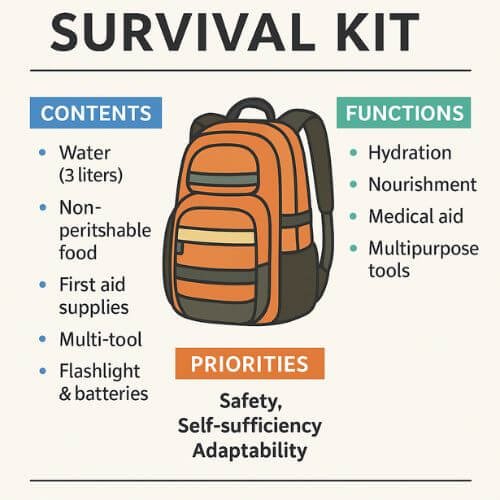
🗂️ 6. Keep an Updated Inventory
In a crisis, you won’t have time to dig and guess.
Maintain a clear, up-to-date list of what’s in your kits. Use a laminated checklist or waterproof card.
Include:
- Gear list (with quantities)
- Expiration dates (batteries, meds, food)
- Refill notes (used or damaged items)
✅ Bonus: Keep a digital backup of your kit inventory in the cloud or offline phone app.
🔄 Maintaining and Evolving Your Survival Essentials Over Time
Building a survival kit is not a one-time event—it’s an ongoing commitment. Just as threats evolve, seasons change, and gear degrades, your survival essentials must be reviewed, refreshed, and adapted regularly.
In this section, we’ll explore how to keep your gear sharp, your skills sharper, and your mindset ready—whether the next crisis hits tomorrow or in ten years.
🧭 1. Understand That Survival Is a Dynamic Process
One of the biggest mistakes preppers make? Thinking their kit is “done.”
But survival isn’t static. Your needs shift as:
- Your environment changes (seasonal weather, urban vs. rural moves)
- Your skills improve (you may need less gear as you learn more)
- Your health or family structure changes (children, elderly, meds)
🧠 A smart prepper doesn’t just update gear—he updates his assumptions.
📅 2. Set a Gear Audit Schedule
The best survival kits are not the biggest or most expensive. They’re the ones that are maintained.
🧼 Create a 3-tier maintenance cycle:
| Frequency | What to Check |
|---|---|
| Monthly | Batteries, perishables, first aid, seasonal swaps |
| Quarterly | Water rotation, food expiration, rust/corrosion |
| Bi-annually | Pack structure, tear damage, tool sharpness |
Pro tip: Add audit reminders to your calendar. Use clear labels like “BOB Gear Refresh” or “Car Kit Check.”
⚠️ 3. Practice With Your Gear in Realistic Scenarios
The most expensive gear is worthless if you’ve never used it under pressure.
🔥 Practice ideas:
- Start a fire in wet weather
- Pitch your tarp blindfolded
- Purify water from a muddy puddle
- Open an MRE in the dark with gloves
- Bandage your leg using one hand only
⛺ Survival is a physical skill, not just a packing checklist. Train accordingly.
🧠 4. Evolve With Threat Awareness
The world is changing fast. Climate events, geopolitical instability, pandemics, supply chain breakdowns—each brings new challenges.
Update your survival essentials as:
- New gear tech becomes available (lighter, more durable, multifunctional)
- Threats evolve (cyberattacks, chemical spills, urban violence)
- Your personal risk map changes (new region, job, travel)
🌍 Example:
Moving from Morocco to Canada? Replace your heatstroke supplies with insulation gear and ice-proof tools.
🎯 Adaptation is the true superpower of preparedness.
🔄 5. Rotate Consumables & Check Expiry Dates
Expired meds, stale power bars, corroded batteries… all silently degrade your kit’s reliability.
⏳ Checklists to rotate:
- Water: store-bought = 6–12 months; home-filled = 3–6 months
- Food: check MRE dates, vacuum seals, energy bars
- Meds: painkillers, antihistamines, personal prescriptions
- Batteries: alkaline = 1–2 years; lithium = up to 10
- Fire tools: test lighters, waterproof matches, ferro rods
🧪 Rotate them into your daily use before they expire—nothing is wasted.
👨👩👧👦 6. Revisit Your Family or Group Needs
Your survival plan must grow with your household.
✅ New baby? Add diapers, wipes, children’s meds.
✅ Elderly parent? Add mobility aids, medical records, larger font labels.
✅ Pet? Don’t forget food, leash, collapsible bowls.
Survival gear is not “one size fits all.” It’s personal.
📘 7. Keep a Prepper Journal
Sounds old-school, but it works.
Use a notebook or digital log to:
- Record gear tests and failures
- Track upgrades and wishlist items
- Log training exercises and outcomes
- Reflect on what worked in drills
This becomes your prepper memory, helping you avoid past mistakes and refine your survival strategy.
🧠 Final Thoughts
Survival isn’t about having the biggest knife or the fanciest pack.
It’s about readiness—sustainable, adaptive, and practiced.
By maintaining your survival essentials, you build more than just a kit.
You build confidence. You build clarity.
You build the ability to protect yourself and others—no matter what comes next.
❓ Frequently Asked Questions (FAQ) – Survival Essentials
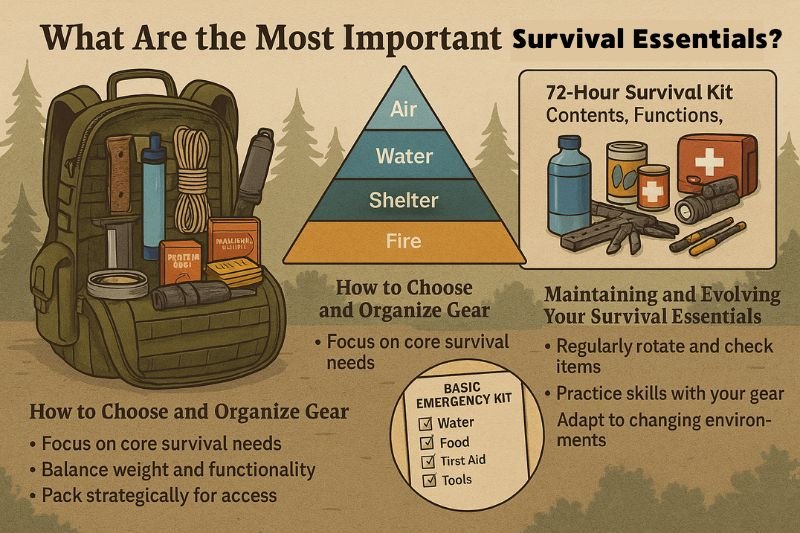
🔹 Q1: Why do survival essentials focus so much on fire, water, shelter, food—isn’t gear like weapons more important?
Because those four pillars address the first threat to your life: your body’s basic survival needs.
You can live weeks without confrontation, but only 3 days without water, and mere hours in extreme cold.
Weapons and defense tools are valuable—especially in urban or unstable environments—but they come after you’ve secured your survival base.
Imagine having a loaded weapon but no fire when temperatures drop below zero. Gear hierarchy isn’t about what’s cool—it’s about what keeps you alive.
✅ Essentials keep you breathing. Defense keeps you protected. One doesn’t replace the other.
🔹 Q2: How do I know if I’ve packed “too much” or “not enough”?
That’s one of the most common beginner questions—and a valid one.
The truth? There’s no universal answer. But here’s a good rule of thumb:
→ Your kit should be light enough that you can move with it for 1–2 hours without stopping,
→ but complete enough to sustain you for 72 hours without outside help.
A 40-liter pack is typically ideal for most bug-out essentials, while an EDC fits in a small sling or belt pouch. The goal is balance: enough gear to cover the core needs, but not so much that it becomes a burden.
🧠 Tip: Practice walking with your full pack over stairs, uneven ground, and in bad weather. If you’re winded in 10 minutes, you’ve overpacked.
🔹 Q3: Isn’t it better to just buy a ready-made survival kit?
You can, but it’s rarely better.
Most pre-made kits sold online:
- Contain low-quality gear
- Lack customization for your local environment or personal needs
- Are heavily overpriced
- Often skip critical items like personal medications, socks, feminine hygiene, or backup fire tools
The best survival kit is the one you build yourself, because you know:
- What’s inside
- How to use it
- How to replace or repair it
- That every item was chosen for your reality
🎒 Survival is personal. Your kit should be too.
🔹 Q4: How often should I update or rotate my survival gear?
Short answer: More often than you think.
Here’s a basic guideline:
- Monthly → batteries, first aid supplies, meds
- Every 3–6 months → food, water, tool condition, fire gear
- Every season change → clothing, climate gear, local threat assessment
Even the best survival essentials degrade over time.
Fire starters corrode. Food goes stale. Plastic cracks in extreme cold.
And your own needs evolve: a new baby, an injury, or a changed location all affect your kit.
Set recurring calendar reminders—think of it as preventive maintenance for your survival.
🔹 Q5: What if I live in a city—do I still need survival gear?
Absolutely. Urban environments pose unique survival challenges, often more psychological than physical.
Urban crises include:
- Power outages
- Civil unrest
- Building evacuations
- Gas leaks
- Cyberattacks on infrastructure
Even 48 hours without electricity in a city can trigger water shortages, food waste, theft, blocked elevators, and breakdowns in public safety.
Your urban survival essentials should be:
- Discreet and mobile
- Focused on light, communication, defense, and safe escape routes
- Adapted to tight spaces and fast movement (i.e. no huge packs)
🌆 Survival isn’t just for the woods. Cities collapse too—faster than you think.
🔹 Q6: Do survival essentials change depending on the season?
Yes—and dramatically.
Winter gear focuses on insulation, fire, high-calorie food, and protection from frostbite.
Summer kits shift toward water storage, shade creation, and managing overheating.
Even your fire kits need to adapt: lighters may fail in the cold, and tinder must resist humidity in the rainy season.
🧭 Smart preppers either:
- Rotate gear seasonally (every 3 months), or
- Maintain modular kits (ex: summer/winter pouches stored separately and swapped)
🥶🔥 Weather kills more quietly than bullets. Prepare accordingly.
🔹 Q7: I’m overwhelmed. Is there a beginner checklist to start with?
Yes. Here’s a bare minimum survival essentials list for a 72-hour emergency, designed to cover basic needs:
✅ 72-Hour Basic Survival Essentials:
- Water filter + purification tablets
- Energy bars or dry food
- Ferro rod + waterproof matches
- Fixed-blade knife
- Headlamp + spare batteries
- Mylar blanket or tarp
- Paracord (25 ft min)
- Basic first aid kit
- Local map + compass
- Cash + emergency contact sheet
- Multitool
- Whistle
It all fits in a 30–40L pack and covers water, warmth, energy, signaling, and first aid.
🎯 Start small. Refine as you learn. The most important step is beginning.
📌 Final FAQ Reminder
When the power’s out, the streets are empty, and you’re alone—your survival essentials are all you’ve got.
Gear isn’t about looking “tactical.” It’s about staying alive and functional.
Choose what you understand, carry what you can use, and never stop testing.









